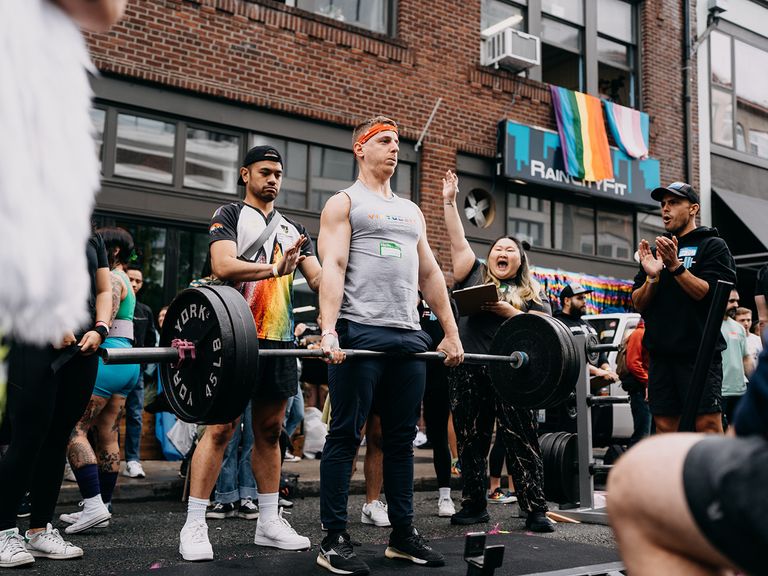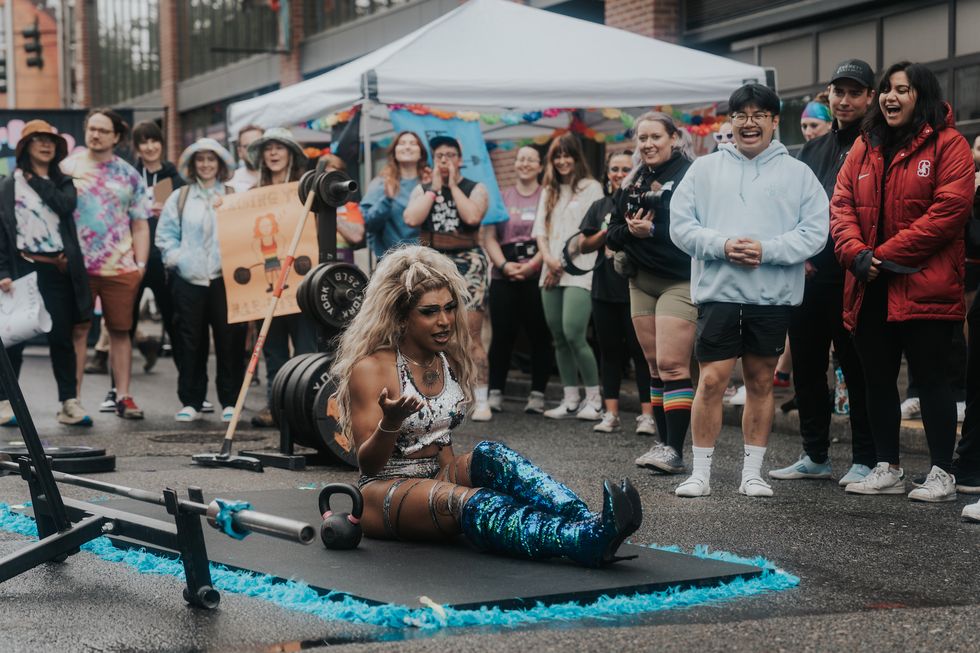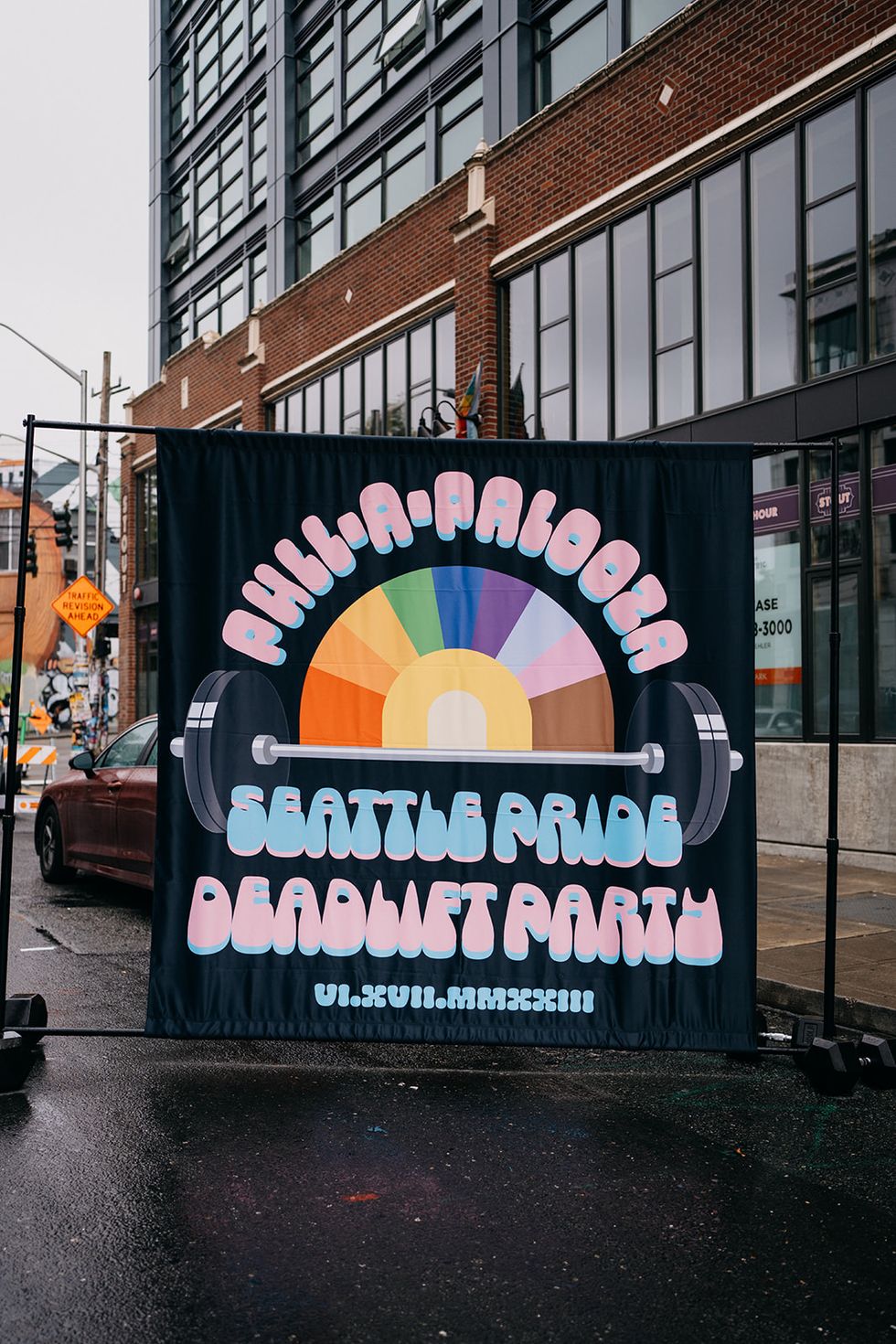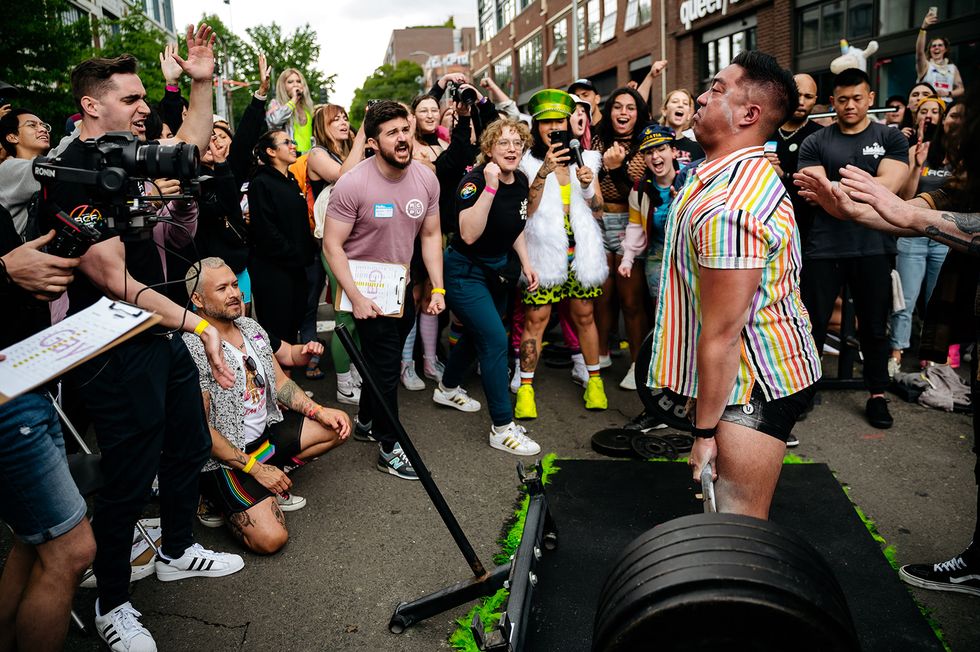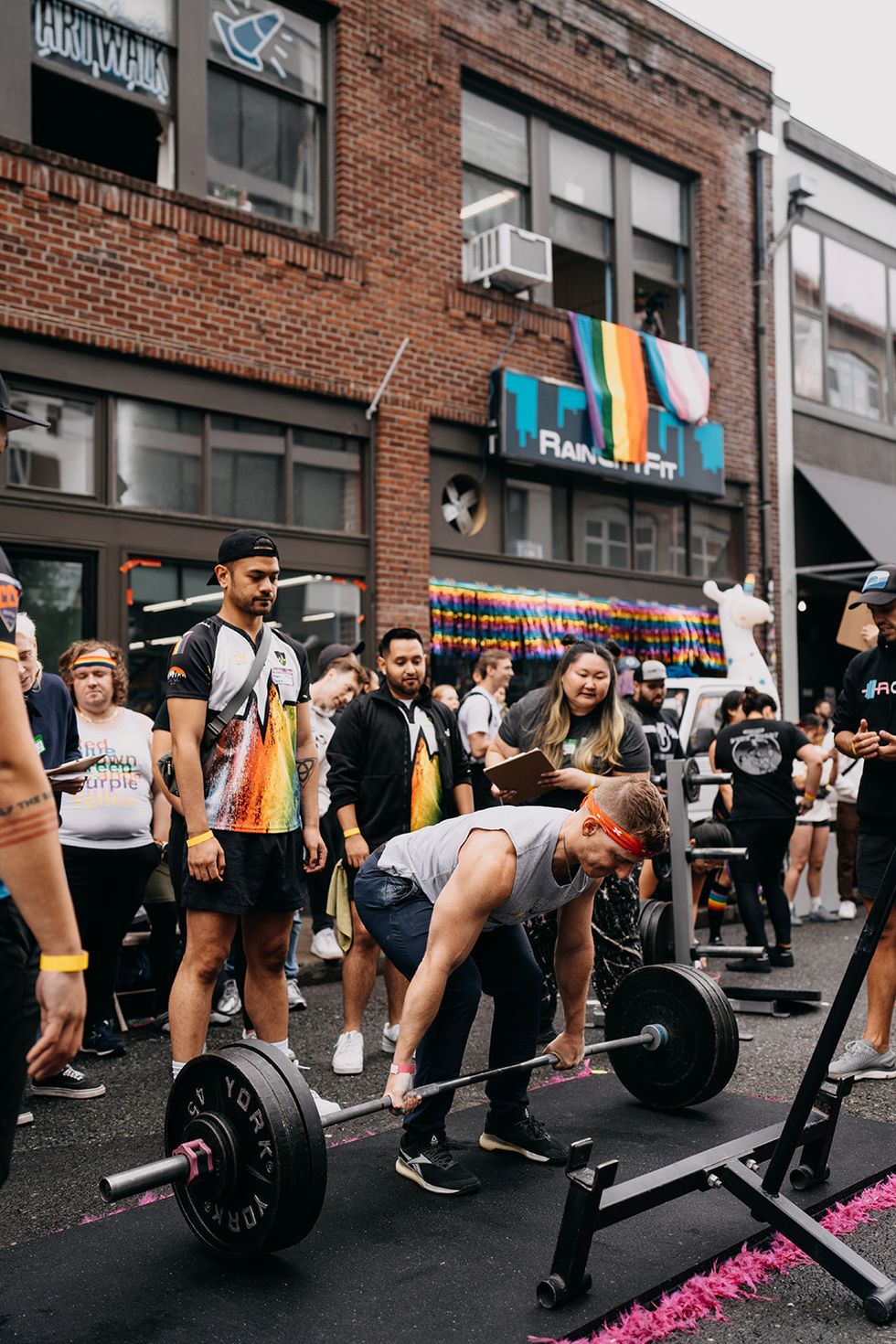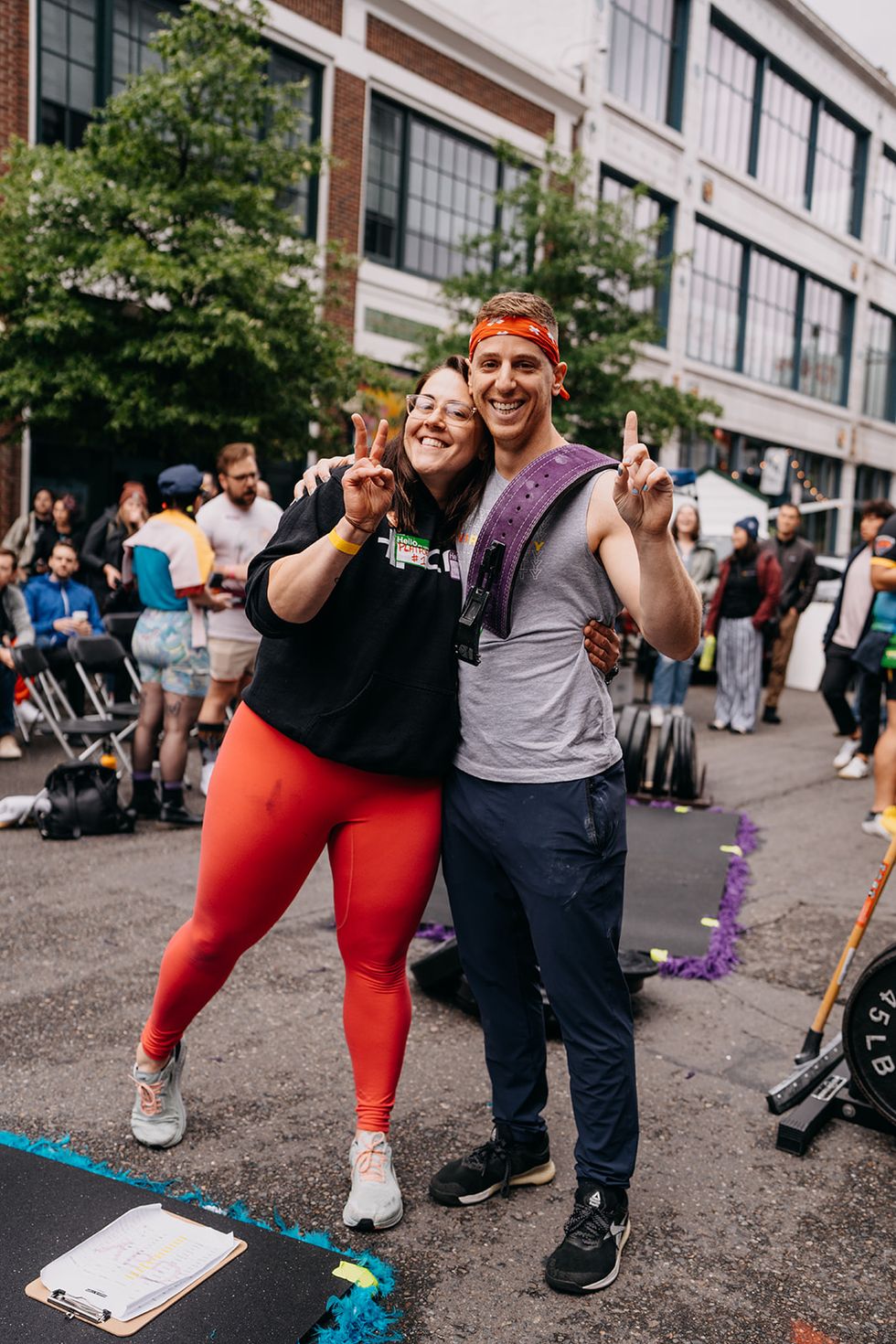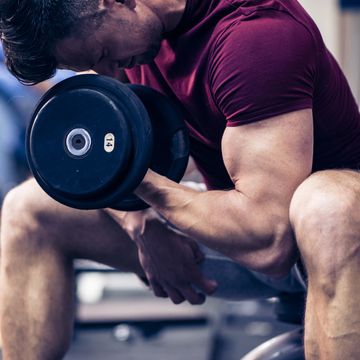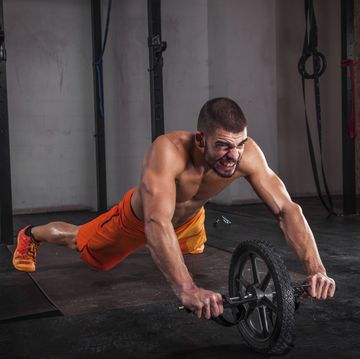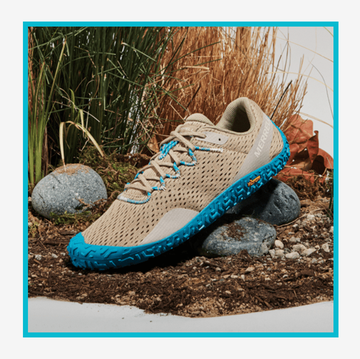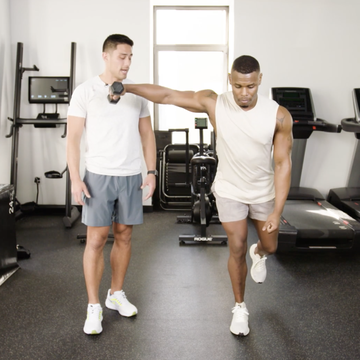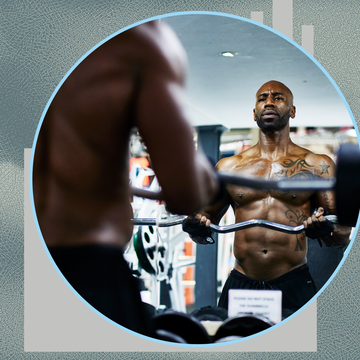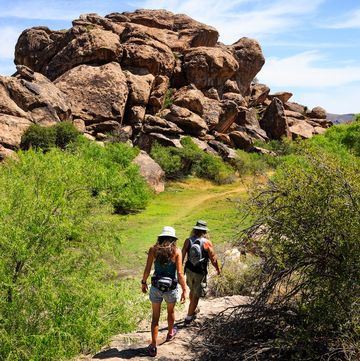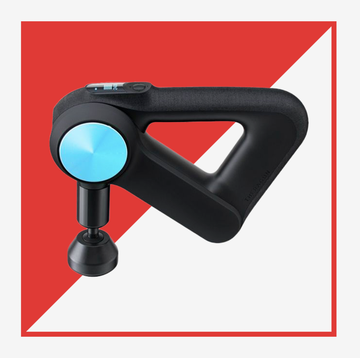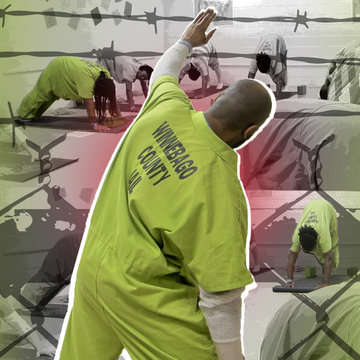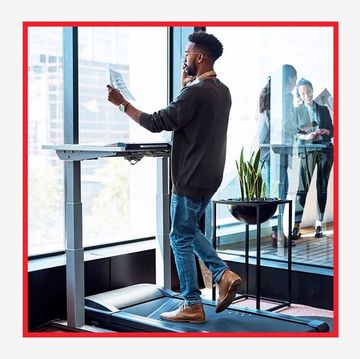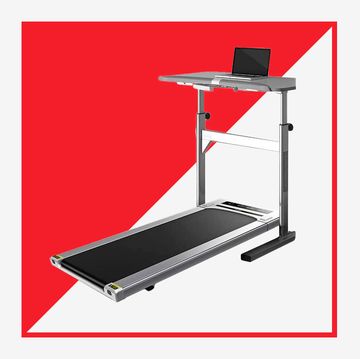IT WAS HARD to stay preoccupied about my opening deadlift weight while the drag queen performed in the Seattle rain. Every time I’d wonder whether I should start at 315 pounds or something heavier, she’d turn a cartwheel or grab a dollar bill or hip thrust on the lifting platforms. At one point, she biceps curled a metal plate and then threw it on the ground with a loud clang. During another, she throttled the barbell jack used to quickly load and unload plates and tried to mount it like a stripper pole. Instead, she fell onto her ass, and the crowd roared.
Pride Pull-A-Palooza was less of a competition and more of a “deadlift party” for LGBTQIA2+ athletes. We all gathered to find a new one-rep max on a closed-down street in the heart of Seattle’s Capitol Hill gayborhood. This wasn’t my first contact with queer athletes—including me, 40 percent of the coaching staff at my Brooklyn CrossFit gym is gay, and I’d guess that about as many of our members are, too. For Pride this year, we got custom t-shirts and ran our annual commemorative workout.
Pull-A-Palooza, however, was unlike any event I'd ever attended. There were no gender divisions, weight classes, or rules around knee sleeves and lifting belts, tools that can lend lifters extra support to nail a rep. The event also allowed participants to pull conventionally or in a sumo stance, which the internet loves to hate, and prizes went to the athlete with the best costume, not to who pulled the most weight.
It was a radically different model than the one I know best: the CrossFit Open, the annual three-week competition that starts the CrossFit season. The other 49 weeks of the year, I’m laid back, not logging my scores on the gym’s leaderboard and only noting how heavy other athletes are lifting when I’m coaching. But each of the five years I’ve done the Open, I’ve become a different person.
Even though I know I won’t make it to the next stage of the competition (too weak, bad engine), I obsess about my score, formulating ways to improve and even re-doing the notoriously brutal workouts. I look up what percentile I’m in worldwide. I pour over the scores of other guys in my gym. Wait—the bro who’s never been great at toes-to-bar got the same number as me?
This approach gets results. During the Open, I put up scores that I can’t imagine replicating once it’s all over. But is that because I stress about keeping up with everyone else? Or is it because I go into the workouts having accepted that this is a special occasion and I’m willing to suffer extra? That’s all to say: Without the normal ways that I motivate myself, can I really lift more than I ever have at an anti-competition competition?
The day of Pull-A-Palooza, I was nervous who I'd see outside of Rain City Fit, the host gym. The block party had three things that really trigger far-right extremists: drag queens, trans people, and children. The event was MCed by Kitty Glitter, a glitter-bearded queen in a neon green, Borat-style thong suit, and other queens performed between each of the three heats of lifters. Meanwhile, trans athletes were especially encouraged to participate, as were gender-nonconforming lifters. Kids were also allowed to both compete and spectate, which didn’t bode well given the current sociopolitical climate. Already this year, bigots have brought guns and lobbed smoke grenades at demonstrations outside of events with queer folks and children, like drag story hours.
Leanna Carr, a sports-exercise psychologist, strength coach, and co-organizer of the event, had told me that they were hiring security guards just in case. “Hopefully there won't be any counter-protesters,” they’d said. “But I won't be surprised, you know?”
Instead, waiting in the drizzle was a small crowd with encouraging homemade signs. The DJ had already started spinning, and the grills were firing up for the cookout. “Powerlifting meets can be really boring because you're just watching the same thing over and over again,” Carr told me. To keep the show running as tightly as possible, 75 volunteers were there to organize the lifters, strip the barbells, and judge the lifts, including Quake, Seattle’s gay rugby team.
While a typical powerlifting event has 50 to 60 lifters, Pull-A-Palooza had already registered 265. “I cannot definitively say that this is the biggest deadlift Pride competition that's ever happened,” Carr told me, laughing. “But I’m almost pretty positive that it's the biggest deadlift Pride competition that's ever happened.”
I made my way to the check-in table, wrote my name and pronouns on a name tag, and hopped on an Assault bike. My hip flexors, quads, and hamstrings were still tight from the flight the day before, but they slowly warmed up.
I hadn’t found my deadlift one-rep max in over a year—it was 365 pounds then—and I'd never participated in a powerlifting lifting meet. I kept second-guessing my strategy. Do I open heavy so I can make small jumps on the way to my new (fingers crossed) PR? Or do I go light to get some momentum? You could only load more weight on your bar, not take it off, so the last thing I wanted was to fail.
I instinctively looked for a guy around my size so I could copy his warmup plan, but Carr had figured out a better way to guide athletes through the process. “This is an extremely intimidating experience,” they’d told me. “So we went through and chose the most energetic and supportive people to be team captains and rally you through the entire experience.” My team captain assured me that 315 was a good opener—something I knew I could hit fairly easily—but said I could change my number up until my first attempt. To finish warming up, he suggested I lift 275, 295, and 305 with a few minutes of rest between reps.
I noticed that a woman, Anna, was also opening at 315. Women outlift me all the time—one fellow coach’s four-rep deadlift is more than my one-rep max— but I’d never competed against them directly. In CrossFit, they live on a different leaderboard.
All 12 athletes in my heat were warming up using one barbell. Nearly all of them were women, including a pregnant one, and many were pulling sumo style. I thought about the rainbow flag that Barbend had just posted on its Instagram account, and the number of reply guys who’d rushed to make the same tired joke in the comments: “We appreciate your support for those that pull sumo.” Wow, I thought, the loser energy of being so concerned about how other people lift.
I told a woman her deadlift looked great, and she returned the compliment. This was her first lifting meet, too, and we laughed nervously as we were led outside to the lifting platforms. But before we pulled, a drag performance.
Thanks to the volunteers, it was a quick transition between lifters, and my new friend was one of the first people to pull. She approached the barbell, which was just 10 pounds heavier than I saw her do easily in the warmup. She started her pull and for two long seconds, her legs shook and her shoulders bulged while the crowd of 150 people cheered. But the bar never lifted off the ground. She was the first in our heat to fail a lift, and she got the loudest applause of anyone who’d gone so far.
The judge didn't raise a red flag or shoot off an air horn to signal the failed lift. In fact, he didn’t do or say anything as my friend exited the platform and got hugs from the other competitors. I saw that the stakes are low—not even Kitty Glitter was roasting her—but I was still nervous for my own prospects. If I couldn't hit 315 on my first attempt, I wasn't sure I could recover.
I approached the barbell, flipped my grip, and pulled my shoulder blades down. Then I pushed the ground away and stood up with the weight. An easy lift, exactly what I hoped. For my second attempt, I considered 335, but then Anna hit her lift. Reflexively, I decided on 345.
The second time around, my friend somehow bounced back and hit her opening weight, though no one got more love than the 12-year-old on the platform next to me lifting about 65 pounds.
I pulled 345 fairly easily on my second attempt. The crowd was less impressed. Again, I wondered how big of a jump to make. After Anna hit the weight, I saw that she was going to 375. That felt comfortable to me. It would be a new PR, and if Anna thought she could do it, didn’t that mean that I could, too?
But I wanted to go heavier and chose 385. If I pulled it, it’d be the most weight I’d ever moved in my life. I wasn’t competing for a sponsorship or expecting to qualify for another stage of competition, but I still wanted to PR.
As I began to fret over that choice—what if Anna made her attempt and I didn’t?—I looked around at the other lifters. There were wigs and rainbow tights and a tramp stamp that said “Condragulations” in bubble letters. Carr was wearing a sleeveless faux-fur vest, and a woman’s shirt read, “I’m here / I’m queer / My anxiety is moderate to severe.” At the platform next to me, Kitty Glitter was commenting on someone pulling 185. “Wow, that sure looks like a lot of weight to me!” she told the crowd.
As hard as I’d tried to leave my CrossFit Open mentality in Brooklyn, I realized that it had followed me here. Oh God, I thought, do I have the same brain rot as those pick-me mouth-breathers complaining about sumo pulls on Instagram?
I exhaled and told myself it’d be okay to fail.
I approached the bar, flipped my grip, and pulled my shoulder blades down. I used my lats to pull the weight in close to my shins and tried to stand. I trembled. But I stood it up and waited for the judge to raise his hand.
I got hugs and daps from my team captain, my friend, and the other athletes in my heat. Most of them PRed as well, and nearly everyone was smiling and high-fiving. I found my friends, family, and boyfriend and watch a recording of my last pull. It never looks as good as it feels, but I was still thrilled.
I can easily compete in any other powerlifting meet I want. Meanwhile, trans athletes can compete in only a handful of powerlifting federations, including USA Powerlifting, which caved only after a judge's order. At the same time, 22 states and the House of Representatives have passed laws banning trans students from participating in sports consistent with their gender identity. In at least one state, the bill originally allowed for the inspection of trans' students genitals, though that provision was later removed. Recently, a nine-year-old in Canada was heckled at a track meet by a man who insisted her parent’s prove that she was born female.
This kind of body policing is encouraged by our current competition model, which often frames girls’ and women's success as grounds for suspicion. Yet even one of the largest sports federations in the world isn’t sure how to define its gender categories. Under the International Olympic Committee’s old guidelines, women needed to have testosterone levels under a certain threshold to compete, which ended up disqualifying two cisgender runners from Namibia in 2021. Later that year, the IOC changed its stance completely, writing that the relevance of testosterone to athletic performance varies from sport to sport, and that even elite male athletes could have testosterone levels in the normal women’s ranges. “There is thus no scientific consensus on how testosterone levels can be used across sports to define unfair and disproportionate advantage,” its updated guidelines read.
Events like Pull-A-Palooza can offer a new way of thinking about competition—not just in the types of athletes that are allowed to be included, but also in the relationships it encourages between them. The fitness world loves to lecture about competing against no one but yourself. That's harder than you think. It takes practice at events like Pull-a-Palooza, which make it clear that you're deadlifting with everyone else, rather than against them. You only have to overcome the voice in your head.
I was in line for the cookout when I saw that my friend was getting a fourth attempt on the platform. I felt a pang of FOMO. Who said we could go again? I considered running over and asking for a crack at 405, but my adrenaline was shot and my grip was toast. When she made her final pull, she smiled, and so did I. We both did what we had come to do—and thanks to the tone of this singular type of event, we were celebrated for putting in the effort.
